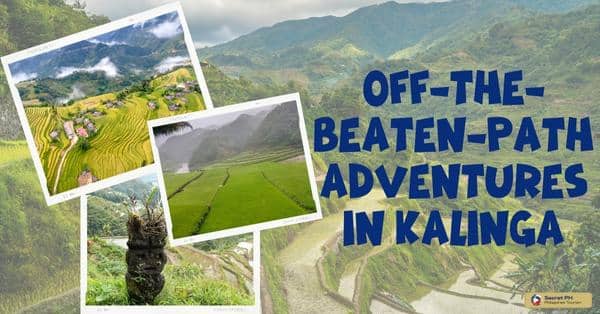Apayao is a province in the northern part of the Philippines widely known for its friendly people and vibrant culture.
Apayao’s friendly people joyfully share their rich cultural heritage with open hearts. From vibrant festivals and traditional music to delicious cuisine and skilled craftsmanship, they take pride in their cultural treasures. With a strong sense of community, they actively preserve and pass on their indigenous knowledge, ensuring their traditions thrive for generations to come.
In this article, we will explore the many wonders of Apayao, from its cultural treasures to its strong community spirit. Discover why Apayao is an incredible place to visit. And find out how you can get involved in preserving this unique region’s traditions.

Hospitality and Warm Welcomes: Embracing Visitors with Open Arms
The friendly people of Apayao are renowned for their exceptional hospitality and warm welcomes. Embracing visitors to their province with open arms. Steeped in a culture of kindness and generosity, Apayao’s residents go above and beyond to make guests feel welcomed and cherished.
From the moment visitors set foot in Apayao, they are greeted with genuine smiles and a sincere desire to ensure their stay is memorable and comfortable. Apayao’s hospitality extends beyond mere gestures of kindness. The locals are eager to share their cultural traditions, stories, and way of life with visitors, providing them with an immersive and enriching experience.
Whether it’s through traditional dance performances, engaging conversations, or inviting guests to partake in local festivities and rituals, Apayao’s people wholeheartedly embrace the opportunity to connect with others and foster cultural understanding. Their warm welcomes create a sense of belonging and leave a lasting impression on visitors, making Apayao a destination where the beauty of the land is complemented by the warmth of its people.

Traditional Festivals: Celebrating Apayao’s Vibrant Culture
The province of Apayao is known for its rich cultural heritage and vibrant traditions. As a way of preserving and showcasing their customs, the people of Apayao celebrate various festivals throughout the year. These festivities are a time for the community to gather, dance, sing, and share their unique heritage with visitors from all over the world.
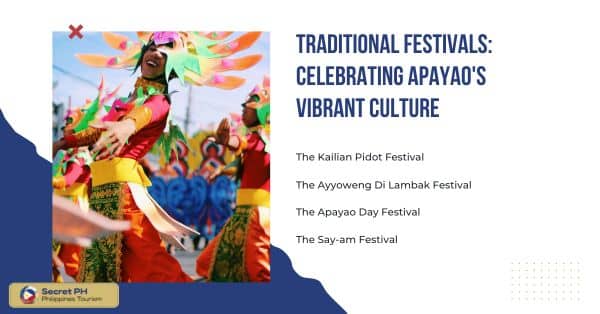
The Kailian Pidot Festival
One of the most popular festivals in Apayao is the Kailian Pidot Festival. This event is celebrated every February in honor of the province’s foundation day.
The festival features various activities such as a street parade, indigenous games, and cultural presentations. One of the highlights of the Kailian Pidot Festival is the “Pidot” ritual, where the locals offer prayers and thanksgiving to their ancestors.
The Ayyoweng Di Lambak Festival
The Ayyoweng Di Lambak Festival is another significant event in Apayao. This celebration happens every May and highlights the province’s agricultural abundance. The festival promotes the importance of farming and honors the hard work of the local farmers. Visitors can experience a showcase of traditional farming practices and enjoy a wide array of local cuisine.
The Apayao Day Festival
The Apayao Day Festival happens every November and is an annual celebration of the province’s culture and traditions. The festival includes street dancing competitions, cultural performances, and a grand parade. Visitors can witness the colorful and elaborate costumes worn by the locals, showcasing their unique cultural identity.
The Say-am Festival
The Say-am Festival is a religious celebration that happens every December in Apayao. This festivity is dedicated to the patron saint of the province, Saint James the Apostle. The festival includes various activities like a street parade, a bazaar, and a cultural presentation. The Say-am Festival emphasizes the importance of faith and spirituality in the province’s culture.

Traditional Music and Dance: Preserving Apayao’s Artistic Expressions
Within the vibrant cultural tapestry of Apayao, traditional music, and dance hold a special place. Serving as powerful expressions of the region’s artistic heritage.
The friendly people of Apayao take great pride in preserving and showcasing these artistic traditions. Ensuring that their cultural expressions continue to thrive. Through their dedication to traditional music and dance, Apayao’s residents bring to life the rich rhythms and captivating movements that are deeply rooted in their cultural identity.
Traditional Musical Instruments of Apayao
Apayao’s cultural heritage is deeply intertwined with the enchanting sounds of traditional musical instruments. These instruments, with their distinct tones and rhythms, form the rhythmic heartbeat of the region’s artistic expressions. The people of Apayao take great pride in preserving and showcasing these musical treasures. Which have been passed down through generations, adding depth and vibrancy to their cultural traditions.
Gangsa: These bronze gongs, commonly played in ensembles, produce mesmerizing rhythms that form the backbone of Apayao’s traditional music. They come in different sizes and are played with mallets, creating a harmonious blend of deep tones.
Kudyapi: A two-stringed guitar-like instrument made from wood, the kudyapi produces soulful melodies that evoke a sense of nostalgia. Its resonating sound fills the air, accompanying songs and dances, and adding a touch of melancholy beauty to the musical landscape.
Subing: Known as the nose flute, the subing is a unique wind instrument made from bamboo. Played by blowing into the nostril hole, it produces hauntingly beautiful melodies, often used to serenade loved ones or accompany rituals and ceremonies.
Tulali: A vertical flute made from bamboo, the tulali produces sweet and melodic tones. It is often played to express emotions, share stories, and enhance the atmosphere of gatherings and celebrations.
Bangibang: This traditional mouth harp is made from bamboo and emits a distinct twanging sound. It is played by plucking the metal reed, creating rhythmic patterns that add a layer of intrigue to Apayao’s music.
Kulibet: A small bamboo xylophone-like instrument, the kulibet produces bright and cheerful tones. Its delicate sound contributes to the liveliness of traditional music, creating an atmosphere of celebration and joy.

Folk Songs and Chants
The rich cultural heritage of Apayao finds expression not only in vibrant dances and rhythmic instruments. But also in the enchanting melodies of folk songs and chants.
Passed down through generations, these harmonious tunes tell stories, convey emotions, and celebrate the traditions and values cherished by the friendly people of Apayao. From heartfelt ballads to lively chants, these folk songs and chants form an integral part of Apayao’s cultural tapestry.
Kumang: This traditional love song expresses deep emotions of longing and devotion. Sung in the native languages of Apayao, the melodic tunes and heartfelt lyrics convey the essence of love and longing, touching the hearts of listeners.
Salidumay: A joyful and celebratory song, Salidumay is often performed during festivals and gatherings. It portrays the unity and happiness of the community, with its lively rhythms and catchy melodies inspiring people to dance and join in the festivities.
Diona: A chant-like song accompanied by a rhythmic clapping, Diona is often performed during agricultural activities and rituals. Its repetitive and hypnotic melody sets the pace for communal work and reflects the strong bond between the people and the land.
Hudhud: Hudhud is a traditional chant of the Ifugao people, who reside in Apayao and neighboring provinces. These oral epics recount stories of heroes, ancestors, and mythical beings, serving as a repository of the community’s history and values.
Begnas Songs: Begnas is a traditional thanksgiving ritual in Apayao, and Begnas songs are sung during this occasion. These songs express gratitude to deities and ancestors, honoring the bountiful harvest and seeking blessings for the community.
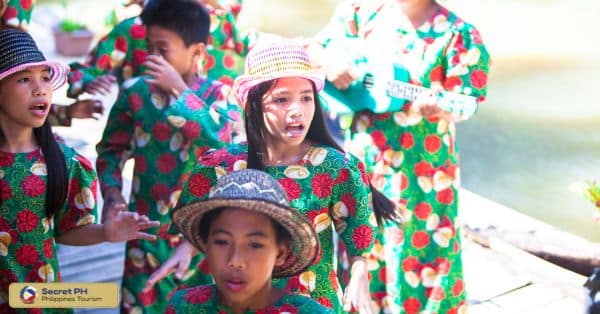
Traditional Dances of Apayao
Apayao’s cultural heritage comes alive through the captivating movements and graceful choreography of its traditional dances. These vibrant expressions of art and culture reflect the history, beliefs, and values of the friendly people of Apayao. Each dance tells a story, conveying legends, rituals, and aspects of everyday life, showcasing the region’s rich cultural tapestry.
Banga Dance: This dance, performed by women, showcases their strength and agility as they balance heavy clay pots (banga) on their heads. The synchronized movements and intricate footwork depict the daily tasks of fetching water and carrying the harvest, paying homage to the hardworking spirit of Apayao’s women.
Takiling: Originating from the Gaddang tribe in Apayao, the Takiling dance depicts courtship rituals. The dancers, adorned in traditional attire, gracefully move and spin, symbolizing the playful exchanges between men and women as they express their affection and intentions.
Kadangyan: Kadangyan is a dance that portrays the power and nobility of the warriors of Apayao. With vigorous movements, the dancers imitate the skills and techniques of combat, showcasing bravery and agility while paying homage to the ancestral heroes and the region’s martial traditions.
Salidsid: Salidsid is a celebratory dance characterized by its lively and energetic movements. Dancers perform intricate steps, jumps, and spins, accompanied by the rhythmic beat of gongs. It is often performed during festivals and special occasions, infusing joy and merriment into the atmosphere.
Apayao Courtship Dance: This dance reflects the rituals of courtship and marriage within the Apayao community. Dancers perform graceful movements, portraying the sweetness and charm of young suitors wooing their partners. The dance highlights the importance of love and family within Apayao’s cultural fabric.

Traditional Cuisine: A Gastronomic Journey through Apayao
Apayao is a landlocked province in northern Luzon, known for its rugged terrain and lush forests. Its cuisine is heavily influenced by the indigenous tribes that have called the province home for centuries, such as the Isneg, Kalinga, and Tingguian peoples. The cuisine of Apayao is characterized by its simplicity, with most dishes consisting of locally-sourced ingredients like rice, vegetables, and meat.
Must-Try Dishes:
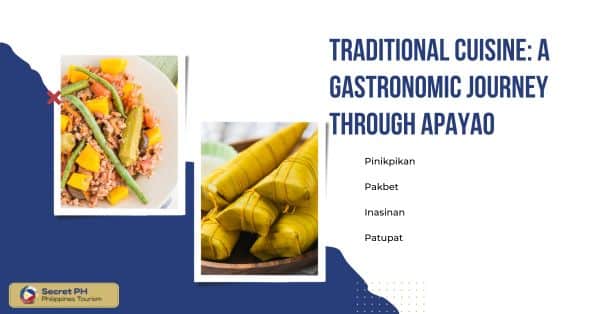
Pinikpikan
Pinikpikan is a traditional dish that is unique to the Cordillera region. It is made by slaughtering a live chicken by beating it with a stick until it dies of a heart attack, then plucking and gutting it. This practice is controversial, and many animal rights advocates are pushing for it to be banned. However, for the people of Apayao, pinikpikan is an important cultural tradition that is believed to bring good luck and health.
Pakbet
Pakbet, also known as pinakbet, is a vegetable dish that is popular throughout the Philippines. In Apayao, it is made with a mix of local vegetables like bitter melon, eggplant, okra, and tomato, sautéed in garlic and onions, and seasoned with fish sauce. It is often served as a side dish to complement meat or fish dishes.
Inasinan
Inasinan is a smoked meat dish that is popular among the Isneg people of Apayao. It is made by curing and smoking meat over a slow fire until it is tender and flavorful. The meat can come from various sources, including pork, beef, and carabao (water buffalo).
Patupat
Patupat is a popular snack made from glutinous rice that is wrapped in woven palm leaves and boiled until it is cooked through. It is often served with sugar or coconut milk and can be enjoyed as a sweet or savory dish.
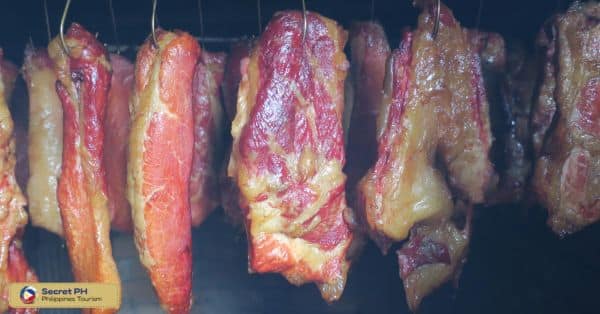
Indigenous Crafts and Artistry: Showcasing Apayao’s Skillful Hands
Apayao is not only known for its natural beauty and warm hospitality. Also for its rich tradition of indigenous crafts and artistry. The skillful hands of the friendly people of Apayao have been honed through generations, creating intricate and captivating crafts that reflect the region’s cultural heritage and creativity.
Indigenous Crafts and Artistry:
Traditional Weaving: Apayao is renowned for its traditional weaving, with intricate designs and patterns that reflect the cultural symbols and stories of the region. The skillful weavers use traditional looms and natural materials like abaca fiber, rattan, and bamboo to create textiles such as blankets, baskets, and traditional garments.
Pottery: Apayao’s pottery traditions date back centuries, with skilled potters shaping clay into beautiful vessels and utilitarian items. Using traditional techniques, these artisans mold, shape, and fire clay to create jars, pots, and intricate figurines adorned with unique patterns and motifs, showcasing the rich artistic heritage of the region.
Bamboo Craftsmanship: The versatile bamboo is skillfully transformed into a wide range of crafts in Apayao. From baskets and mats to musical instruments and intricate home decor, the artisans of Apayao showcase their expertise in working with bamboo, crafting functional and aesthetically pleasing items.
Woodcarving: The art of woodcarving in Apayao demonstrates intricate craftsmanship and attention to detail. Skilled artisans carve wood into sculptures, statues, and decorative objects, often depicting ancestral figures, mythical creatures, and symbols of local folklore, keeping the cultural stories and traditions alive through their art.
Beadwork and Jewelry: The people of Apayao display their creativity and artistry through intricate beadwork and jewelry making. Using a combination of natural materials, like seeds, shells, and colorful beads, artisans create beautifully crafted accessories, such as necklaces, bracelets, and earrings, showcasing the region’s unique aesthetic.

Community Spirit and Unity: Apayao’s Strong Bonds
In Apayao, the spirit of community and unity runs deep within the friendly people. Apayao’s strong bonds are evident in the way they come together to celebrate festivals, support one another in times of need, and preserve their cultural traditions. The sense of belonging and solidarity permeates every aspect of life in Apayao, creating a harmonious and inclusive community.
The people of Apayao actively participate in communal activities and events that strengthen their bonds. Festivals, such as the Say-am Festival and the Apayao Foundation Anniversary, bring the community together in vibrant displays of music, dance, and colorful costumes. These celebrations serve as platforms to showcase their cultural heritage, fostering a shared sense of pride and identity.
Moreover, the friendly people of Apayao demonstrate their unity through mutual support and cooperation. During challenging times, such as natural disasters or emergencies, the community swiftly rallies together to provide assistance and aid. From collective efforts in rebuilding damaged homes to organizing relief operations, Apayao’s strong bonds shine through their unwavering support for one another.

Preserving Cultural Heritage: Apayao’s Efforts for Future Generations
Apayao recognizes the significance of preserving its cultural heritage for future generations. The friendly people of Apayao are deeply committed to safeguarding their traditions, customs, and artistic expressions, ensuring that their rich cultural legacy endures.
Through various efforts and initiatives, Apayao showcases its dedication to preserving its cultural heritage. Allowing future generations to embrace and appreciate the unique identity of the region.

Revitalizing Traditional Practices: Keeping Customs Alive
The friendly people of Apayao actively engage in revitalizing traditional practices. Ensuring that customs and rituals continue to be a vibrant part of community life.
Elders and cultural leaders play a pivotal role in passing down ancestral knowledge and skills to the younger generation. From indigenous farming techniques to rituals and ceremonies. Apayao’s efforts to preserve and promote traditional practices ensure that they remain integral to the fabric of the community.
Documentation and Archiving: Preserving the Past
Recognizing the importance of preserving the past, Apayao has invested in documentation and archiving initiatives. Local historians, cultural researchers, and community members work together to collect oral histories, compile traditional stories, document craftsmanship techniques, and record cultural practices. By creating archives and repositories, Apayao ensures that the cultural heritage is preserved for future generations to learn from and appreciate.
Cultural Festivals and Celebrations: Showcasing Heritage with Pride
Apayao’s cultural festivals and celebrations are vibrant showcases of the region’s heritage. These events provide opportunities for the friendly people of Apayao to come together. Proudly displaying their traditional costumes, performing ancient dances, and showcasing their craftsmanship.
Festivals like the Say-am Festival and Apayao Foundation Anniversary not only celebrate cultural diversity. But also serve as platforms to educate visitors and younger generations about Apayao’s cultural heritage.

In conclusion
Apayao is a place where culture and tradition thrive. Through the vibrant dances of its people, the unique flavors of its cuisine, and the skillful craftsmanship of its artisans, Apayao showcases its cultural heritage with pride.
Above all, it is the strong bonds between the friendly people of Apayao that make this region truly special. Their unwavering commitment to preserving and celebrating their cultural heritage ensures that the traditions of Apayao will live on for generations to come.







